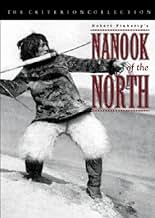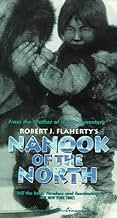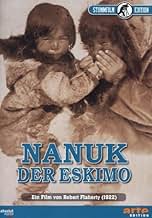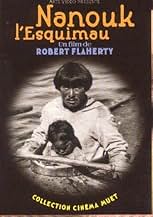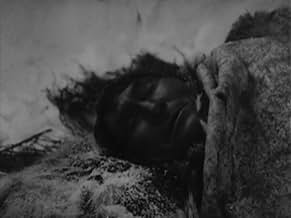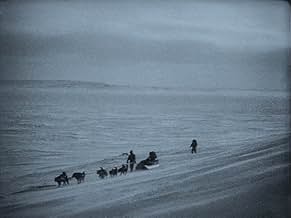CALIFICACIÓN DE IMDb
7.6/10
14 k
TU CALIFICACIÓN
En este predecesor mudo del documental moderno, el cineasta Robert J. Flaherty pasa un año siguiendo la vida de Nanook y su familia, inuits que viven en el Círculo Polar Ártico.En este predecesor mudo del documental moderno, el cineasta Robert J. Flaherty pasa un año siguiendo la vida de Nanook y su familia, inuits que viven en el Círculo Polar Ártico.En este predecesor mudo del documental moderno, el cineasta Robert J. Flaherty pasa un año siguiendo la vida de Nanook y su familia, inuits que viven en el Círculo Polar Ártico.
- Dirección
- Guionistas
- Elenco
- Premios
- 2 premios ganados en total
- Dirección
- Guionistas
- Todo el elenco y el equipo
- Producción, taquilla y más en IMDbPro
Opiniones destacadas
As a documentary turning point, Nanook of the North is undoubtedly one of if not the most significant work of the twentieth century. The story of Nanook and his family became the center of attention of the national media and virtually altered the perceptions the world had of film for documentary purposes. Flaherty may be to the documentary world what J.R.R. Tolkien is to the fantasy world. He is the giant of the genre. For its time, Nanook of the North was a masterpiece. Simple and profound, the story of Nanook was unique, and henceforth the foundation upon which the great documentarians of the 20th century created their works. However, through hindsight, the film falters. Most noticeable is the fact that Flaherty composed each of these sequences ahead of time and purposefully altered Nanook's life in order to make it seem harsher. In what is one of the most famous scenes, Nanook laughs at a phonograph and bites into a record as if he does not understand it. However, it was discovered later that not only had Nanook seen phonographs before, but he was a regular visitor to the trading post, owned a snowmobile and a rifle, and had probably seen a record player before. This fact puts into question the strength of this work as a documentary. Flaherty defended himself, claiming that some things need to be altered in order for the message to be seen. However, this is what we in the film world call "fiction". Plenty of fiction is based upon fact, but when you call something a documentary, it is held up to a different standard, one that Flaherty's work, although, good, fails to achieve.
This is a fascinating documentary from Robert Flaherty, a very prolific director of early documentaries. He follows the adventures of the Eskimo Nanook, and we get to see what life was like for the Eskimo in the early 20th Century as we watch Nanook with his family, hunting for food, and building igloos.
This is really amazing stuff for 1922. It feels like it could have been made long after that. That's probably due to the fact that it relies on real settings and real people. It's not bound by the restrictions of manufactured sets, costumes, etc. of the period. However, though it looks utterly authentic, don't be fooled into thinking that Flaherty gives us a purely realistic snapshot of Eskimo life. He planted the early seeds of reality t.v. with this film, making careful use of editing to create a narrative with all of the melodramatic trappings of any studio picture. Though it's a fascinating film, it's also a reminder that documentary film is just as manipulative as fiction, and that Michael Moore wasn't the first to corner the market on presenting fiction as fact.
Grade: A
This is really amazing stuff for 1922. It feels like it could have been made long after that. That's probably due to the fact that it relies on real settings and real people. It's not bound by the restrictions of manufactured sets, costumes, etc. of the period. However, though it looks utterly authentic, don't be fooled into thinking that Flaherty gives us a purely realistic snapshot of Eskimo life. He planted the early seeds of reality t.v. with this film, making careful use of editing to create a narrative with all of the melodramatic trappings of any studio picture. Though it's a fascinating film, it's also a reminder that documentary film is just as manipulative as fiction, and that Michael Moore wasn't the first to corner the market on presenting fiction as fact.
Grade: A
Nanook of the North was a delight to watch from start to finish. What is captured on film is a priceless glimpse into an Eskimo family's life from the early days of film-making. Some people consider the film to be pejorative; particularly in the portrayal of Nanook as simple-minded enough to think little people live inside a phonograph speaker; or in the next frame where he is portrayed confusing a phonograph record with something to eat. I was not offended by this; conversely, considering when the film was made these scenes were endearing to me. Ultimately, what I like best about this film are the close-ups of Nanook and his family, particularly his children. The emotions expressed on their faces when they are happy and playful or sad and afraid reveal the universal link we all share as humans. It is a link that transcends the vast spaces of both cultural distance and time. The film is a masterpiece!
"Nanook of the North" is a film that shows the life of Nanook and his family back in 1920 in the frozen North of Canada. Most of the film shows Nanook hunting and fishing--most other activities are not seen.
I'll be honest about this one--"Nanook of the North" is NOT a film for everyone. It's a semi-documentary with very limited appeal. I am not surprised that it was released as part of the ultra-artsy Criterion Collection. After all, how many people want to see a film about the life of the Inuit in Northern Canada?! However, for fans of documentaries, it's well worth seeing, as it's one of the very early ones. But you might have noticed that I called it a 'semi-documentary'--a term that should be used more often. That's because a true documentary shows what is--not a fictional account of what is. And, while what you see is typical in some ways about the Inuit, it was NOT typical of the Inuit in 1920. These folks no longer hunted and lived like they did in this film due to their contact with the outside world. And so, what you see is more like the Inuit BEFORE they made contact with the modern world. Apparently, in 1920, these folks were using guns and other modern bits of technology that are not shown in the film. Additionally, the filmmaker staged much of the film. For example, Nannok's wife in the film really isn't his wife! But with all these problems, is the film worthless? Certainly not!! It's fascinating from start to finish and is more like a recreation of ancient Inuit life--and in this sense, it's an invaluable record--but one most people probably don't care much about today--mostly it's a film for academicians and film historians.
I'll be honest about this one--"Nanook of the North" is NOT a film for everyone. It's a semi-documentary with very limited appeal. I am not surprised that it was released as part of the ultra-artsy Criterion Collection. After all, how many people want to see a film about the life of the Inuit in Northern Canada?! However, for fans of documentaries, it's well worth seeing, as it's one of the very early ones. But you might have noticed that I called it a 'semi-documentary'--a term that should be used more often. That's because a true documentary shows what is--not a fictional account of what is. And, while what you see is typical in some ways about the Inuit, it was NOT typical of the Inuit in 1920. These folks no longer hunted and lived like they did in this film due to their contact with the outside world. And so, what you see is more like the Inuit BEFORE they made contact with the modern world. Apparently, in 1920, these folks were using guns and other modern bits of technology that are not shown in the film. Additionally, the filmmaker staged much of the film. For example, Nannok's wife in the film really isn't his wife! But with all these problems, is the film worthless? Certainly not!! It's fascinating from start to finish and is more like a recreation of ancient Inuit life--and in this sense, it's an invaluable record--but one most people probably don't care much about today--mostly it's a film for academicians and film historians.
Robert J. Flaherty's `Nanook Of The North' may be the first film about man's relationship with nature. Flaherty helps establish man's successful adaptation to his environment by filming extraordinary hunting and fishing scenes consisting largely of medium shots. The few close-ups of the Inuit generally portray the successful hunters smiling as they eat their kill. Flaherty contrasts these moments with sequences communicating the Inuit's struggles with the natural world. Here, he uses long shots: Nanook and his family become tiny black specks barely visible in the large, white frame. In the foreground the viewer sees bitter gusts of wind ruling over the desolate landscape. Flaherty's technique is simple but very effective. Not only does he depict man as a mere part of his environment, but he emphasizes how powerless man may feel amid the cold indifference of nature. At the same time, the hunting and feast sequences establish Nanook as a smart, tough survivor, a surprising victor over nature's harsh elements. In this way, Flaherty makes Nanook into a heroic figure.
Rating: 9.5
Rating: 9.5
¿Sabías que…?
- TriviaThe claim that Allakariallak died of starvation in 1922, months after the film was completed, is untrue; he did not starve but likely succumbed to tuberculosis.
- Citas
Title Card: The shrill piping of the wind, the rasp and hiss of driving snow, the mournful wolf howls of Nanook's master dog typify the melancholy spirit of the North.
- Créditos curiososA story of life and love in the actual arctic.
- Versiones alternativasRemastered with image enhancement, speed correction and a new score in 1998
- ConexionesEdited into Saumialuk. Le grand gaucher (1990)
Selecciones populares
Inicia sesión para calificar y agrega a la lista de videos para obtener recomendaciones personalizadas
- How long is Nanook of the North?Con tecnología de Alexa
Detalles
Taquilla
- Presupuesto
- USD 53,000 (estimado)
- Tiempo de ejecución
- 1h 18min(78 min)
- Mezcla de sonido
- Relación de aspecto
- 1.33 : 1
Contribuir a esta página
Sugiere una edición o agrega el contenido que falta


